Unit 4
Electrical Circuit Analysis using Laplace transform
Consider an LTI system by a complex exponential signal of the form
x(t) = Gest.
Where s = any complex number = σ+jω
σ = real of s, and
ω = imaginary of s
The response of LTI can be obtained by the convolution of input with its impulse response i.e.
y(t)=x(t)×h(t)=

Where H(S) = Laplace transform of 
Similarly, Laplace transform of 
For unit step function:
u(t) = 0 t<0
1 t>0
L {u(t)} = F(s) =  -st dt = 1/s
-st dt = 1/s
For impulse function
∂(t) = { 0 t
1 t=0 }
L [∂(t)] = F(s) =  e-st dt = 1
e-st dt = 1
Unit ramp function:
r (t) = 0 t ≤ 0
t t≥ 0
L { t u(t) } =  e-st dt = t (-1/s e -st ) | 0 ∞ -
e-st dt = t (-1/s e -st ) | 0 ∞ -  e-st dt
e-st dt
= 0 + 1/s  e-st dt
e-st dt
= 1/s (-1/s e -st ) | 0 ∞
= 1/ s 2
Exponential function:
f(t) = e-at u(t) where a > 0 and u(t) is the unit step function
F(s) =  dt
dt
F(s) =  at e -st dt
at e -st dt
- e – (s+a) t / s + a | t=0 t=∞ = 1/ s + a
Sinusoidal function
L { sin(wt)} =  jwt – e – jwt / 2j . e -st dt
jwt – e – jwt / 2j . e -st dt
= 1/2j [ 1/ s – jw – 1/ s + jw ] = w/ s2 + w2
Cosine function
L [ coswt] =  jwt + e – jwt / 2 . e -st dt
jwt + e – jwt / 2 . e -st dt
= ½ [ 1/s-jw – 1/ s+jw] = s/ s2 + w 2
Find the Laplace transform of x(t):


x(t) = x1 (t) + x2(t) = u(t-2) – u(t-4)
L{x(t)} = X(s) = 1/s e -2s – 1/s e -4s
X(s) = 1/s ( e -2s – e -4s)
Consider LTI system which is initially relaxed at t=0. If the input to the system is impulse then the output of the system is denoted by h(t) and is called the impulse response of the system.
h(t) = T|∂ (t)|-------------------(1)
We know that any arbitrary signal x(t) can be represented as
x(t) =  (
(
 (t-
(t- dτ ----------------------------------------(2)
dτ ----------------------------------------(2)
The system output is given by
y(t) = T[x(t)] ----------------------------------------------------------------------(3)
Substituting (2) in (3) we get
y(t) = T [  ∂(t-
∂(t- dτ -----------------------------------------------(4)
dτ -----------------------------------------------(4)
For linear system
y(t) =  ∂(t-
∂(t- dτ --------------------------------(5)
dτ --------------------------------(5)
If the response of the system due to impulse ∂(t) is h(t) then the response of the system due to delayed impulse is
h(t,τ) = T [ (t -τ) d τ -------------------------------------------------------(6)
(t -τ) d τ -------------------------------------------------------(6)
y(t) =  h(t,
h(t, dτ -------------------------------------------------------------------(7)
dτ -------------------------------------------------------------------(7)
For a time invariant system the output due to delayed input by T is equal to delayed output by T that is
h(t,τ) = h(t-τ) ---------------------------------------------------------(8)
Hence,
y(t) =  h(t-
h(t- dτ -----------------------------------------(9)
dτ -----------------------------------------(9)
This is called convolution integral or convolution. The signal x(t) and h(t) can be represented as
y(t) = x(t) * h(t)
Find the convolution of x1(t) = e -at u(t) and x2(t) = e -bt u(t)
x1(t) * x2(t) =  x2(t-
x2(t- dτ
dτ
A signal x(t) is said to be casual if x(t) =0 for t<0
In this case both the signals x1(t) and x2(t) are casual.
x 1(t) * x 2(t) =  x2(t-
x2(t- dτ
dτ
=  e -at e -b (t-τ) dτ
e -at e -b (t-τ) dτ
= e -bt  e –(a-b)τ dτ
e –(a-b)τ dτ
= e -bt [ e –(a-b)t -1]/ b-a for t≥ 0
= e -at – e -bt / b-a u(t)
We know that
X(s) = F.T [ x(t) e –  t ]
t ]
 -------------------------------(1)
-------------------------------(1)
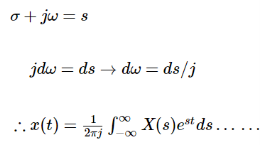 (2)
(2)
If v(t) and i( t) are the voltage across and the current through an inductor of L henries, then
v(t) = L di/dt -----------------------------(1)
The Laplace transform of this equation (assuming zero initial current) is
V(s) = L s I(s) -------------------------------------(2)
Similarly, for a capacitor of C farads, the voltage-current relationship is
i(t) = C dv/dt
And its Laplace transform, assuming zero initial capacitor voltage, yields
I(s) = C s V(s) that is
V(s) = 1/ Cs I(s)
For a resistor of R ohms, the voltage-current relationship is
v(t) = R i(t) and its Laplace transform is
V(s) = R I(s)
Thus, in the "frequency domain," the voltage-current relationships of an inductor and a capacitor are algebraic; these elements behave like resistors of "resistance" Ls and 1/ Cs, respectively.
Resistor :
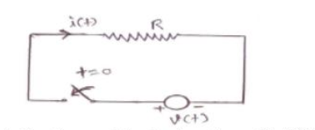
The current voltage relation for resistor is given by : v(t) = i(t) * R
From the above relation it can be said that the instantaneous value of current depends on the instanteneous value of voltage and vice vera.
The past values of current or volatge does not affect present value of current or voltage that is the behaviour of resistance remains same irrespective of past value of current and voltage.
Inductor :
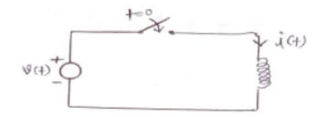
When the switch is closed at t=0 and current throgh an inductor cannot change instantaneously. As a result closing a switch to connect to inductor to a source of energy will not cause current to flow at that instant and the inductor will act as an open circuit.
The current through the inductor is given by

Hence current at 0+ is equal to current at 0-. So if i(0-)=0 then i(0+) =0 also. Hence, it acts as open switch.

If current Io amps flows in the inductor at the instant of switching takes place that current will continue to flow and for the initial instant the (t=0+) inductor can be considered as current source Io amps.

Capacitor:
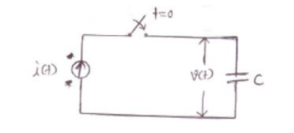
The voltage across capacitor is given by
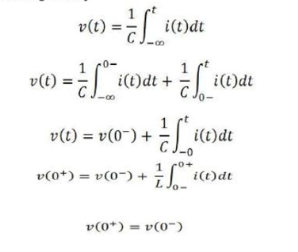
Behavior of elements at t=0 and t=∞

Procedure for evaluating initial conditions:
- Find the current through inductor and voltage across the capacitor before switching that is at t=0 find i(0-) and v(0-)
- Draw the circuit at t=0+ using equivalent for each circuit element.
- Determine i(0+) and v(0+)
- Draw the general circuit after switching
- Write the integro-differential equation for the circuit
- Obtain the expression for di/dt or dv/dt
- Using initial conditions like i(0+) find di(0+)/dt or using v(0+) find dv(0+)/dt . Obtain the expression for d 2 i(0+)/dt 2 or use dv(0+)/dt . Find out d 2 v(0+)/dt 2
Problem:
In the network shown below if at t=0 switch ‘K’ is closed, Find the values of i, di/dt and d 2 i/ d t 2 at t=0+. Assume V =100V , R=1000Ω and L =1H.
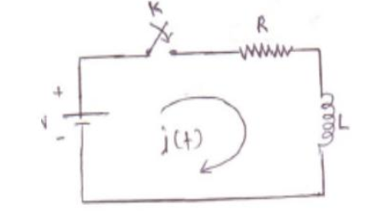
Solution:
Before the switch is closed i(0-)=0
Draw the circuit immediately after switching, Inductor acts as open . Since the inductor will not allow the current to change instantaneously. Hence i(0+) =0
Draw the general network after switching and write KVL
V = Ri + L di/dt
Obtain the expression for first derivative di/dt = (V -R(i))/L substituting the values we get
Di/dt =100 A/s
Obtain the expression for second derivative d2 i(0+)/ dt 2 = R/L di/dt
Substituting the known values we get
d 2 i(0+)/ dt 2 = -100000 A/s2
In the circuit shown switch ‘k’ is opened at t=0. Find the values of v, dv/dt ,
d 2 v / d t 2 at t=0+
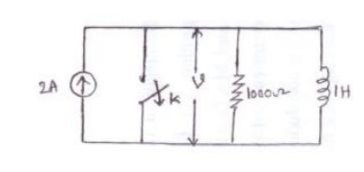
Solution
At t=0-

v(0-) =0 , iL(0-) =0 since current through the inductor cannot change suddenly.
At t=0+

v(0+) = i x R = 2 x 1000 = 2000V
Apply KCL to the given circuit at t=0+ we get
v/R + (1/L)  = 2 -------------------------------------------(1)
= 2 -------------------------------------------(1)
Differentiate equation (1) with respect to t we get
(1/R) dv/dt + (1/L) v =0
At t=0+ the equation becomes
(1/R) dv(0+)/dt + (1/L) v (0+)=0
Dv(0+)/dt = -R/L v(0+)
= (-1000/1) x 2000
= -2 x 10 6 V/S

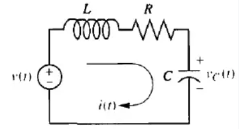
The capacitor voltage is treated as the output and the applied voltage as the input. Summing the voltages around the loop and assuming zero initial conditions yields the integro-differential equation for the network as
L di(t)/dt + R i(t) + 1/C  d
d  = v(t)
= v(t)
Changing variables from current to charge using i(t) = d q(t)/dt yields
L d 2 q(t)/ dt2 + R dq(t)/dt + 1/C q(t) = v(t)
From the table q(t) = C v(t)
LC d2 vc(t)/ dt 2 + RC d vc(t)/dt + vc(t) = v(t)
Taking Laplace transform and assuming initial conditions to be zero
( LC s2 + RC s +1) Vc(s) =V(s)
Hence,
Vc(s) / V(s) = 1/LC / s2 + R/L s + 1/LC
The Laplace transform
For capacitor
V(s) = 1/Cs I(s)
For resistor
V(s) = R I(s)
For inductor
V(s) = Ls I(s)
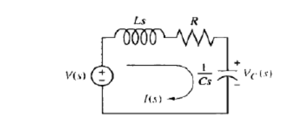
Laplace transformed network
L di(t)/dt + R i(t) + 1/C  = v(t)
= v(t)
Assuming zero initial conditions
(Ls + R + 1/Cs) I(s) = V(s)
I(s) / V(s) = 1/ Ls + R + 1/sC
But the voltage across the capacitor Vq(s) is the product of current and impedance of the capacitor. Thus,
Vc(s) = I(s) / Cs
I(s) = Cs * Vc(s)
Therefore
Vc(s) *Cs/ V(s) = 1/ Ls +R+1/Cs
Vc(s) /V(s) = 1/ Cs(Ls +R+1/Cs)
= 1/ LC s2 + CRs + Cs/Cs
= 1/LC s2 + CRs +1
= 1/LC / s2 + R/L s + 1/LC
Vc(s) / V(s) = (1/LC) / s 2 + R/L s + 1/LC
All poles and zeros of Network function have the form of ratio of two polynomials in s as
G(s) = P(s)/ Q(s)
P(s) is the numerator polynomial in s having degree m while Q(s) is the denominator polynomial having degree n. Hence network function can be expressed as,

Now the equation P(s) =0 has m roots while equation Q(s) has n roots. Thus G(s) can be expressed in the factorized form as

Where z1,z2…….zm are the roots of the equation P(s) =0 and P1,P2……Pn are the roots of the equation Q(s) =0.
K = a0/b0 = scale factor
Thus z1,z2…….zm,P1,P2…….Pn are the values of s and hence are complex frequencies as s variable is a complex variable.
Poles:
The values of ‘s’ that is complex frequencies which make the network function infinite when substituted in the denominator of a network are called poles of the network function.
s = p1,p2……..pn are the poles of G(s)
If such poles are real and non -repeated these are simple poles/ If a particular pole has same value twice or more than it is repeated pole. A pair of poles with complex conjugate values is called pair of complex conjugate poles.
The poles are the roots of the equation by equating denominator polynomial of the network function to zero. Such equation is called the characteristic equation of the network.
Zeros:
The value s that is complex frequencies make the network function zero when substituted in the numerator of network function called zeros of the network function.
s = z1,z2………..zm are the zeros of G(s)
The zeros are the roots of the equation by equation numerator polynomial of a system function to zero.
When the order m > n there are m-n poles at infinity while m<n then n=m is zeros at infinity. Hence for an9y rational network function poles and zeros at infinity and zero are taken into consideration in addition to finite poles and zeros . The total number of zeros is equal to the number of poles.
Example:
For the network function:
N(s) = s 2 (s+3) / (s+1) (s+2+j)(s+2-j)
At s=0 Double zero occurs and s=-3 a zero occurs .
At s=-1 pole occurs
S= -2-j1 and -2 +j1 pole occurs.
N(s) = p(s)/q(s) = (ao/bo) [ (s-z1)(s-z2)………..(s-zn) / (s-p1)(s-p2)…….(s-pm)]
H=(a0/b0) is called the scale factor

H(jw) is expressed in polar form :
Frequency response:

|H(jw)| is the amplitude response
< H(jw) is the phase response
Find the frequency response of the system with transfer function :
H(s) = s+0.1/s+5
Find the amplitude and phase response for input
x(t) = cos 2t.
Substitute s=jw
H(jw) = jw + 0.1 / jw + 5

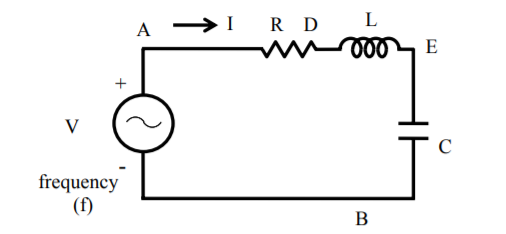
The circuit consists of resistance R, inductance L and capacitor C in series is connected to a single- phase variable frequency (f) supply. The total impedance of the circuit is
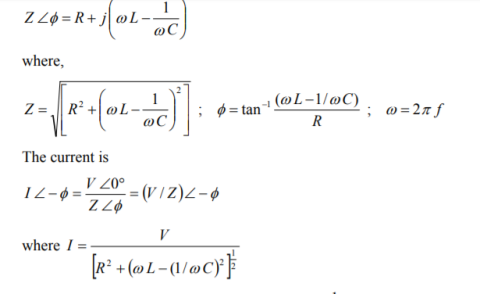
The current in the circuit is maximum if wL = 1/wC
The frequency of the above condition is
f o = wo /2π = 1/ 2π 
The condition under the magnitude of the current is maximum or the magnitude of the impedance is minimum is called resonance.
The frequency under this condition with constant values of inductance L and capacitance C is called resonant frequency.
If capacitance is variable and the frequency is kept constant the value of the capacitance needed to produce this condition is
C = 1/ w 2 L = 1/ (2 π f) 2 L
The magnitude of the impedance under the above condition is |Z|=R with reactance X=0, as the inductive reactance XL= wL is equal to capacitive reactance Xc = 1/wC . The phase angle ɸ=0 and power factor is unity. That means the current is in phase with the input supply voltage . So the magnitude of the current is |(V/R)| in the circuit is and limited by resistance R. The phasor diagram is
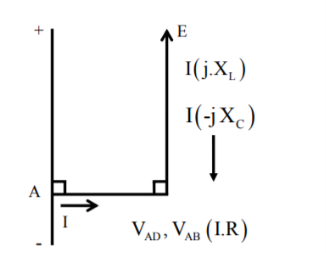
Phasor Diagram.
The magnitude of the voltage drop in inductance L and capacitance C
I wo L = I . (1/ wo C)
The magnification of the voltage drop as the ratio of the input supply voltage is
Q = woL/R = 2 π fo L/R = 1/R 
This is termed as Quality factor of the coil. The impedance of the circuit with constant values of inductance L and capacitance C is minimum at resonant frequency and increases as the frequency is changed that is increased or decreased from the above frequency.
The current is maximum at f-fo and decreases as frequency is changed (f> fo or f<fo) that is f≠fo. The variation of current in the circuit having known the value of capacitance with a variable frequency supply is shown
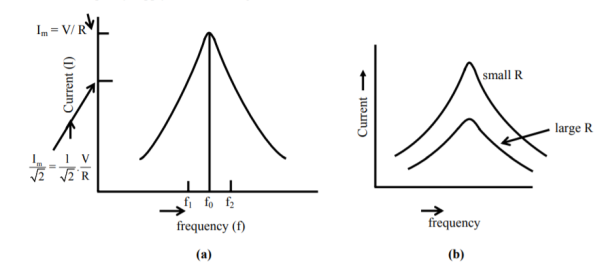
Problem:
A constant voltage frequency 1MHz is applied to a lossy inductor in series with variable capacitor C. The current drawn is maximum when C = 400pF while current is reduced to (1/ of the above value when C=450pF. Find the values of r and L. Calculate the quality factor of the coil and the bandwidth.
of the above value when C=450pF. Find the values of r and L. Calculate the quality factor of the coil and the bandwidth.

Solution:
f = 1MHz w = 2πf C = 400pF
Imax = V/r as XL = Xc = 1/2πfC = 1/ 2. Π . 10 6 x 400 x 10 -12 = 398 Ω.
XL = Xc = 2 π f L = 398 = L = 398 / 2 π . 10 6 = 63.34 μ H
C1 = 450pF
Xc1 = 1/ 2π . 10 6 x 450 x 10 -12 = 353.7 Ω

From the above 
Hence r = 44.3 Ω.
The quality factor of the coil is Q = XL/r = 398/44.3 = 8.984
The bandwidth ∆f = f 2 – f1 = r / 2π L = 44.3 / 2π x 63.34 x 10 -6= 0.1113 x 10 6 Hz.
Parallel Circuit :
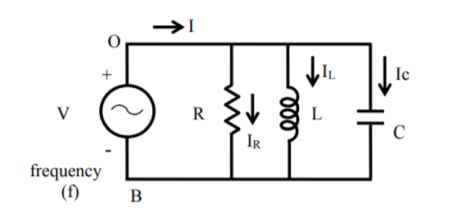
The admittance of the circuit is


The impedance is 
The current is

Where

The current in the circuit is minimum if wC = 1/wL
The frequency under the above condition is
Fo = wo/2π = 1/2π 

The frequency under this condition with constant values of inductance L and capacitance C is called resonant frequency. If the capacitance is variable and frequency f is kept constant the value of capacitance to produce this condition is
C = 1/ w 2 L = 1/ (2 π f ) 2 L
The magnitude of the impedance for the above condition |Z| =R while the magnitude of admittance |Y| = G = (1/R). The reactive part of the admittance is B =0 as the susceptance (inductive) BL = 1/wL is equal to the susceptance (capacitive) Bc = wC. The phase angle ɸ=0 and the power factor is unity . The total current is phase with the input voltage. So the magnitude of the total current (|V/R|) in the circuit is only limited by resistance R. The phasor diagram is shown above.
Problem:
A coil having resistance of 15Ω and inductance 0.75H is connected in series with a capacitor as shown in figure. The circuit draws maximum current when a voltage of 200V at 50Hz is applied. A second capacitor is then connected in parallel to the circuit. What should be its value such that the combination acts like a non -inductive resistance with the same voltage at 100 Hz. Calculate the current drawn by the two circuits.

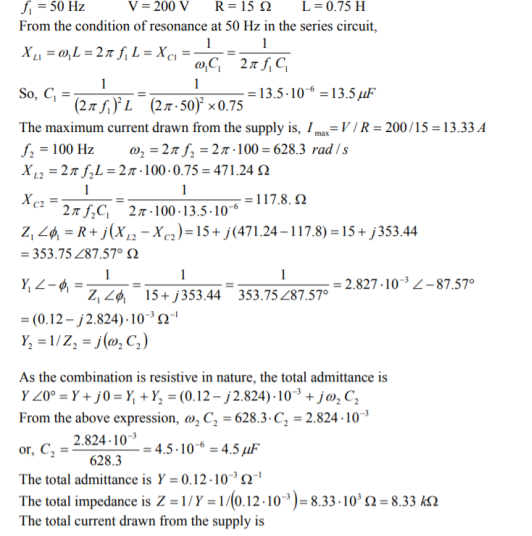

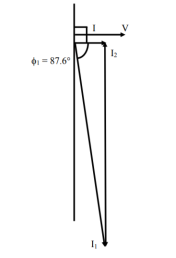
References:
- Network theory by A.V Bakshi, U.A Bakshi
- Network Theory Analysis and Synthesis by Smarajit Ghosh
- Networks: An introduction by Mark Newman
- Network Theory (Bput) book by Satpathy